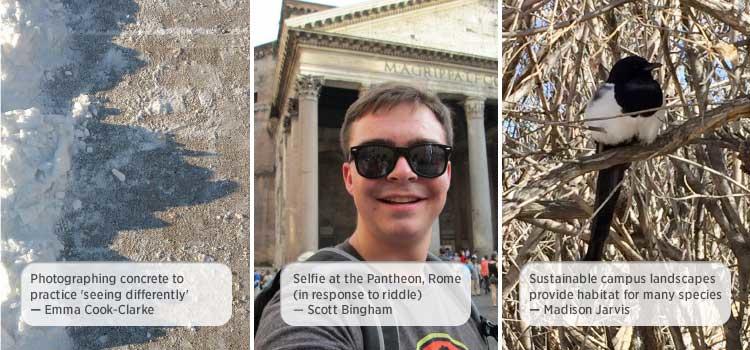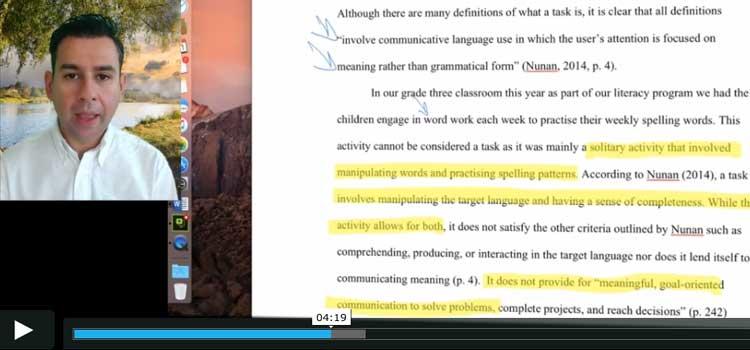
.
Nov. 1, 2017
The days where students only sit in rows, face a lecturer at the front of the room and scribble notes with pen and paper are done. As the scholarship of teaching and learning progresses, researchers are finding innovative methods to engage students – from those studying geography using their iPhones to help understand a sense of place to instructors using iPads to capture and share their thoughts in real time as they grade papers.
While students in some classes still sit in lecture halls, eyes front and pen (or laptop) in hand, others are learning by doing, or, with the help of live streaming video, even engaging in a little friendly competition with their professor.
Faculty at UCalgary are throwing open the doors of pedagogy to incorporate technology, innovation and just plain fun. And by doing so, they’re developing exciting new methods to keep students (and themselves) engaged.

.
Professors have been using photography to teach for nearly a century but these days, with cameras in every pocket, more faculty are working with the ubiquitous smartphone to help educate their students.
“We’re turning the selfie into a tool to have students learn about the environment they’re in,” says Dianne Draper, a professor in UCalgary's Department of Geography, one of many faculty across campus using “disruptive technology” to complement courses including archaeology, earth sciences and geography.
“Students are often preoccupied with grades and they tend to miss the bigger picture in many courses,” she says. “We’re trying to figure out ways to engage students more effectively with the content of the course so they get excited about what they’re actually learning.”
"It's not just about essays or lab reports anymore."
Sometimes, that means handing in a few selfies as part of a photo essay. In a recent environmental geography class, for example, Draper had her students take selfies with and/or pictures of greenery and other biophilic design elements amidst the steel, glass and concrete in downtown Calgary.

.
On a group study program in Italy, Draper’s colleagues Andrea Freeman, Darren Sjogren and Aaron Williams had their students photograph ancient and contemporary infrastructure built to protect against natural hazards, such as earthquakes and landslides.
“Photography encourages students to look closely at the surrounding environment,” says Draper. “They identify concepts and literature that’s discussed in class and communicate a ‘scientific’ story.”
Students are expected to curate their photos and hand in assignments with brief captions explaining the picture. Unlike their Instagram feeds, they present the academic principles illustrated in the photos. The assignments often lead to more communication between student and faculty than when students are assigned a traditional essay.
“We try to help them ‘see differently,’” says Draper. “This is a challenge because they’re used to looking at their little screens and we want them to look more broadly at the environment around them and provide evidence and/or evoke emotion through their photographs”.
Handing in a few selfies as part of a photo essay also helps students acquire some of the communication skills they need to meet the challenges waiting for them in today’s hyper-technological workplaces. “It’s not just about essays or lab reports anymore.”

.
Going to court on TV is one thing, but representing a client in front of an actual judge is something else entirely. Third-year law students are finding out for themselves in an intensive and unique block course that includes presenting their case in a pre-trial conference with a sitting provincial court judge.
The mandatory course used to run one week in January and students would perform a mock trial at the end. But a few years ago, Faculty of Law instructor Lisa Silver expanded the course to three weeks to help students learn to connect their trial skills with legal principles.
“Research shows that performance-based, experiential learning is the best way to teach law,” says Silver, a former criminal litigator. “Really what we’re teaching students is to be a practising lawyer.” And that means knowing how to cross-examine a witness, how evidence works and how to apply the legal principles underlying a case.
"It’s not just about swaggering in and doing an awesome cross-examination."
At the beginning of the course students choose to present either a criminal or civil trial. “There’s a lot of different advocacy skills that go into carrying a case,” says Silver. “It’s not just about swaggering in and doing an awesome cross-examination. You have to do some negotiation, you have to work with a client, you have to draft documents, you have to go before a judge and do a conference.”
Silver enlists the help of 10 justices from Alberta Provincial Court and the Court of Queen’s Bench and 10 trial lawyers for one of the exercises in the course, a pre-trial conference (something you rarely see on TV but that’s increasingly important to minimize delays in the judicial system). The judges and lawyers volunteer their time to hear 130 students role-playing as opposing counsel in 30 cases.
Each student group gets about 20 minutes to discuss what witnesses and evidence they plan to present at trial. “It’s important to know your case well enough that you can go before a judge who is going to say: ‘Well why are you doing this? What’s this for? The justice will push them a little,” explains Silver. “They’re before a real judge so they take it very seriously. The judges and lawyers give them feedback about how they did in the conference and give them tips for their trial.”
The mock trials take place on a Saturday in the Calgary Courts Centre and a few volunteer judges wander in and out of the courtrooms and give feedback. It’s a helpful experience for students, whether or not they plan a career in litigation.
“It’s awesome,” says Silver, who organizes all the volunteers and the courthouse. “As someone coming from practice I know it’s useful for the students. It’s a confidence builder and it’s fun.”

.
When a student gets an assignment back from Soroush Sabbaghan, they receive the paper and a video file that gives his feedback on their work – what’s known as ‘veedback.’
While he didn’t invent the clever term, Sabbaghan, a senior instructor at the International Foundations Program at the Werklund School of Education, has taken the innovative practice for grading to new heights.
A couple of years ago, while teaching academic English for international students at UCalgary, Sabbaghan got an iPad Pro and started recording himself reading students’ assignments out loud while also marking up their copy on the screen.
“The idea was students would hear me think out loud when I read their text,” he says. “You tell them about your impression of their writing and you have to point out grammatical and vocabulary mistakes, talk about whether there was coherence and cohesion in the text and whether the topic was developed.”
Next, he developed a digital rubric to pull up beside a student’s assignment. Now, he could refer to the rubric as he was reading and marking up the text on the screen, offering comments such as: “I’m going to give you a two out of three here because on this occasion, you made a mistake and that’s why I have to take off points.”
“I had no more complaints, ever, because they saw my thinking process."
Almost immediately, students stopped complaining about their marks. “It actually completely wiped it out,” says Sabbaghan. “I had no more complaints, ever, because they saw my thinking process and they saw how I scored based on that thinking process.”
The veedback offers other advantages too – like an easy, equitable and personal connection between teacher and student. “If students come to me and sit in my office, there’s always some sort of a power imbalance,” he says. “Students are often uncomfortable with that, but with veedback you don’t have that issue.”
While Sabbaghan admits it took him a while to figure out a few technical glitches, he’s now able to grade an international undergraduate student’s five-paragraph essay in about eight minutes.
And he can give his graduate students meaningful information and suggestions of research to explore that they incorporate in their studies. “For them, the revelation that a proposition they’re making is incorrect due to so and so’s research is feedback that resonates with them.”
With 20 years of teaching under his belt, Sabbaghan is always looking for new ways and suggestions to improve how he works with students. As for using a red pen to grade their papers, he says it’s “very unlikely” he’d ever go back.

.
Never mind Lilly Singh and all those Minecraft YouTube stars. Students in Elke Lohmeier-Vogel's Biology 205 watched a brand new YouTube channel where fruit flies are the star of the show.
Instead of writing essays about the organization and diversity of life, the students would head over to Biol205 channel on YouTube and spend five minutes a day watching fruit flies buzz around in a vial. The tiny insects go through their entire life cycle in about 15 days so by tuning in every day, the students see the whole series of stages – from adults, to larvae to pupae and back again.
“We want students to observe and record their unbiased observations, just like Darwin might have done, and periodically draw what they observe,” says Lohmeier-Vogel, a senior instructor in UCalgary's Department of Biological Sciences. “Later they graph the amount of time they could observe flies, larvae, pupae and flies again after they hatched.”
"We wanted to give students a completely novel experience."
Students don’t look up any information on the Internet – their eyes stay glued on the livestream from Lohmeier-Vogel’s office. “The set-up consists of a vial containing the flies, a light, a thermometer and a webcam with autofocus that’s connected to a desktop computer for the streaming,” says Laura Perissinotti, a learning technology coach. “We’re not aware of any similar exercise. Everything here was designed from scratch.”
The students logged in from anywhere for the optional assignment worth 4 per cent of the final mark. In the first class in 2016, 75 per cent of the 400 students tuned in and received an average of 80 per cent. “We wanted to give students a completely novel experience, that of observing, recording and graphing and getting curious about something – which is what biologists do,” says Lohmeier-Vogel.
The students were impressed at the complexity of the life cycle, that adult flies appear to chase and push each other and with other fruit fly drama: “Many were surprised that black dots in the food turned out to be the mouths of the larvae,” says Lohmeier-Vogel. “The larvae grew larger and eventually climbed out of the food and up on the glass wall where they turned into pupae.”
While a few students said they would have preferred time-lapse photos of the fruit flies, most enjoyed the opportunity to see nature “as it unfolds in real time.”

.
The official name is ‘Beat the Instructor’ but some students refer to it as ‘Stump the Chump.’ Regardless of what you call it, Brent Snider’s half-hour forecasting exercise is keeping students in supply chain management engaged. “We do a little bit of trash-talking as well, have a little bit of fun,” says Snider, a senior instructor and teaching fellow in operations and supply chain management at UCalgary's Haskayne School of Business.
Before he started challenging his students to beat him at forecasting, he’d simply lecture about how to apply tools to sales data to predict how much product to order. “I thought 'let’s turn it into a game to pique their interest,'” says Snider. “I thought competing against them might be kind of fun because it’s like they’re trying to beat their dad.”
The exercise, co-authored with Haskayne’s Janice Eliasson, has four rounds. In each one, students get a spreadsheet of historical sales data for undetermined products. They get five minutes to come up with a forecast that predicts what that sales of that product will do – go up or down or stay the same.
"Everybody wants to take me down."
Snider enters their predictions and then he does his on a big screen. “I do it really quickly,” he says. “I really don’t explain what I’m doing – I just go ‘blah blah blah’ here’s my number. I am not trying to explain it I’m trying to make them see that it can be done that fast.”
It works. Students want to know how Snider can forecast so quickly and accurately. “I’ve used it with undergrads right up to executive MBAs,” he says. “Everybody wants to take me down.” So far, his students have only managed to win against Snider once. But they learn every time.
Business schools around the world want to learn too. Snider has had emails from colleagues at 82 universities and colleges in 25 countries asking for his teacher’s notes and slides. He’s happy to share.
– – – – –
Participate in a research study
– – – – –
Soroush Sabbaghan is a senior instructor in the International Foundations Program at UCalgary's Werklund School of Education. He has been teaching ESL for 15 years and has studied how native and non-native elementary school children learn mathematics. Read more about Soroush
Lisa Silver joined UCalgary's Faculty of Law full-time in 2016 after two years as a sessional instructor. As a practicing lawyer, she has been involved in Supreme Court of Canada cases and more than 200 appeals before all levels of court in Ontario. As a research lawyer, she has written numerous facta and opinion briefs for matters before all levels of the Alberta courts, including SCC leave applications. She blogs about criminal law and advocacy at ideablawg.ca. View Lisa's publications
Elke Lohmeier-Vogel is a senior instructor in UCalgary's Department of Biological Sciences where she has taught Biochemistry to undergraduate students for 21 years. She recently started teaching biology to first year non-biology majors. Her research interests include developing undergraduate laboratory exercises as well collaborative research with colleagues. Read more about Elke
Laura Perissinotti is a learning technology coach for UCalgary's Faculty of Science and a research scientist in the Biological Sciences Department's Centre for Molecular Simulation. As a learning technology coach, she provides a range of support and resources to instructors around technology integration, helps instructors to improve practices and shares within the teaching community what's worked, what can be adapted, and how to do it. View Laura's publications on ResearchGate
Brent Snider, a senior instructor in the operations and supply chain management area, has been teaching at UCalgary's Haskayne School of Business since 2003. His research interests focus on Enterprise Resource Planning (ERP) systems and innovative experiential classroom exercises. Read more about Brent
Dr. Dianne Draper, PhD, is a professor in UCalgary's Department of Geography. She is recognized for her research in sustainable tourism, ecotourism and tourism growth management, as well as planning and policy in water resources management. Her current research focuses on governance and quality-of-life issues in tourism and other communities. Read more about Dianne